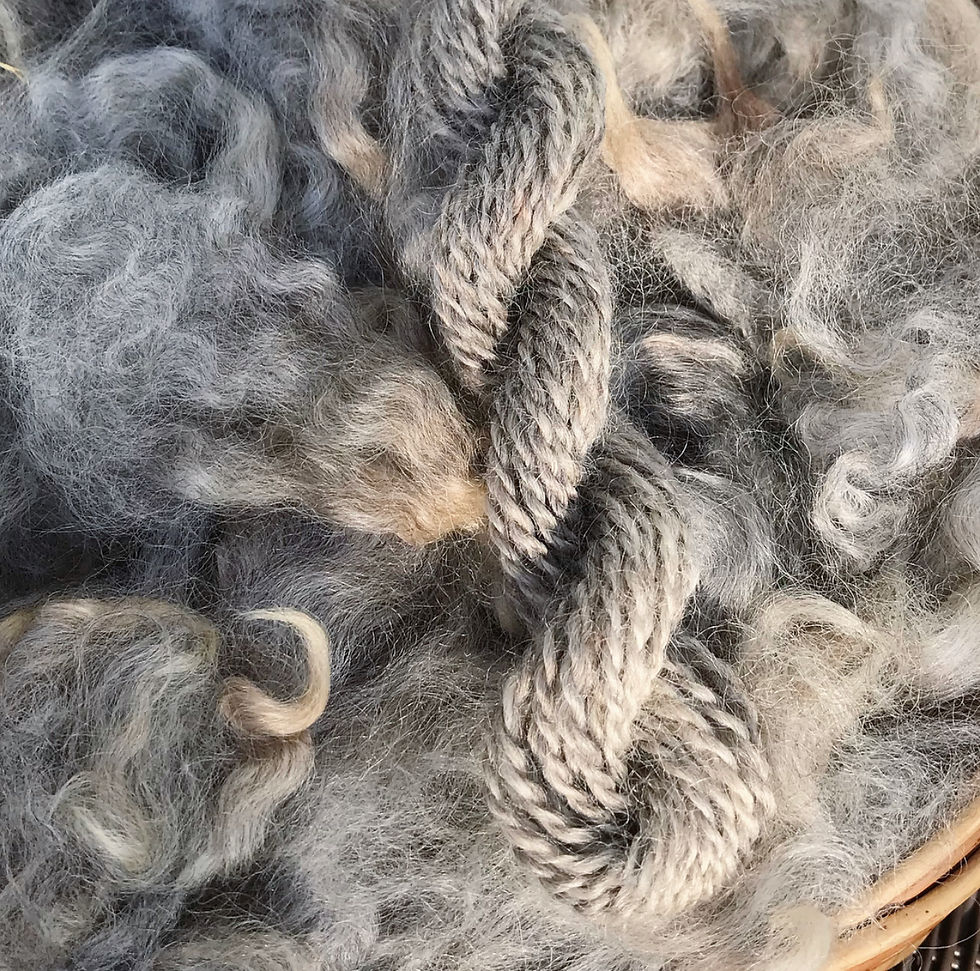How to Wash a Fleece Without Tears!
- Heavenly B.

- Dec 8, 2018
- 4 min read
Let's go on a little adventure...
Take that fleece you have been staring at with googly eyes for days, weeks, months, years... and let's get it clean!
Before we start, I should add this is one of many ways that I use to clean sheep's wool. There are plenty of other methods to use. Feel free to use a way that you are most comfortable. For the sake of this post, I will narrow down fleece-washing to one of the ways that is pretty easy. I use this large-batch method primarily to wash long wools and some medium wools, but not for fine wools. For this post, I am using a 3.5lb Romney that I purchased from Iron Water Ranch in Oregon.

Materials & Equipment
› 5-gallon Bucket (2)
› Unicorn Power Scour
› Measuring Spoon (TBS)
› Pots for Boiling Water
› Heavy Duty Gloves
› Utility Sink for Rinsing
› Nina Soft Spin Dryer*
*If you don't have some of these materials or equipment, feel free to use alternatives.
How It Is Done

Take your fleece and inspect it; check for second cuts, tags (poop), sticks, hay, and other foreign objects. Remove anything that is undesirable.
Weigh your fleece and separate the fleece into 1-1/2 lb sections. Each section is a batch. (Note: Try not to make your batches very large.)
Take one of the 5-gallon buckets and fill it halfway with cold water. Put on your heavy duty gloves. Place one of your batches in the cold water and gently press it down to submerge the fleece in the water. Leave the uncovered bucket alone for 24 - 48 hours. Presoaking helps loosen up the dirt, mud, and other things in the fleece that you might have missed. Many times, the true color shows in the fleece and the water almost instantly turns brown or dark grey.
Heat 7 liters (just under 2 gallons) of water to just boiling on a stove. I use 2 separate pots for this. Take the other 5-gallon bucket and pour the boiling water into it. Next, fill bucket to the halfway mark with hot tap water.
Using the measuring spoon and heavy duty gloves, put 1 tablespoon of Power Scour. Stir (using spoon).
Take your cold soak bucket outdoors. Lift fleece from the cold soak and slowly place it in rectangular baskets to allow them to strain. They can strain over an empty bucket or an area of your choosing. After removing the fleece, I pour the soak water into my garden. My garden loves the 'wool tea'!
Transfer fleece from baskets to the hot water bucket and gentle push the fleece down into the water. Let it sit for 20 minutes.
Fill a spare sink or utility sink with hot tap water. Just enough to cover the entire batch. Put the washed fleece into the sink for a rinse. Make sure the fleece is spread out and not in huge clumps. Let it sit for 30 minutes. Drain the sink. Do this once again. Your last rinse should have less bubbles in it. Also, look for clear water in the sink. If needed, rinse again. Optional: In the last rinse, you can use Unicorn Fibre Rinse or another agent to condition and soften the fibers again.
Take your clean fleece and put it in a spin dryer to spin out excess water.
Remove fleece from spin dryer and place on towels. Allow your fleece to dry fully. Repeat steps 3 - 10 for your following batches.

Once you get the hang of it, you can clean more than one batch at a time. I hardly ever need to wash a fleece more than 1 time using this method and power scour, but each fleece is different. I typically have one wash, two rinses. One tip I have to offer is make sure there are no tags in your fleece or you may be washing and rinsing for a very long time. Ask me how I know...
The second batch that I begin washing for this post ended up sitting in a cold soak for 4 days! I could have started a suint bath... Luckily, it only required one wash, I used less soap ~3/4 TBSP, but it took 3 rinses. That batch also looked identical to the first batch after drying. I will stick to the 24-48 hour soak.
Are you a first-timer?
If trying this for the first time, my suggestion would be to check your fleece stash for a long wool, i.e. Border Leicester, Coopworth, Perendale, Romney or even BFL. Why a long wool? When washing in large batches, the fibers are fully submerged and become disoriented; however, with long wools, it is much easier to recognize the tip and butt ends of the fibers despite this fact. This is helpful for combing.
Thank you so much for checking out this blog post, perhaps down the line I can make a post for methods of cleaning finer wools. As a thank you, I have made a resource available for your personal use. The free download was available for the first 40 readers. The option to purchase the worksheets are available here!
Now It's Your Turn!
Spinner Question: Do you prefer spinning commercially-processed or hand-processed fibers?
Preparation Questions: Are you a first-time fleece-washer? If so, what is the most intimidating part about cleaning fleece? If you are not a first-timer, what is your favorite way to wash fleeces? Do you have favorite types of fleeces to clean?





Comments